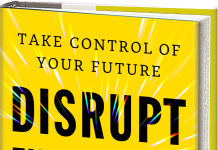An accountable person working Above The Line who practices the 16 Accountability Traits disrupts the norm of how things are done. By being disruptive, we mean they are rocking the boat, shaking things up, or taking a break from the way people are used to doing things.
Of course, the objective isn’t just to take risks, it’s to get results. But that often can’t happen unless you are willing to place your bets on different strategies and tactics, understanding that the chance of failure is always present. That often means trying something that might fail in order to bring about a highly desirable result you could obtain no other way.
Take a Risk, Be Disruptive
One fact that has become clear from our research and work with leaders from all over the world is that the Solve It mentality requires you to take the necessary risks and embrace disruption in order to solve the tough challenges people face in business today. When it comes to business success on both the personal and organizational levels, disruption is the new normal.
It’s easy to see this in entrepreneurs who disrupt entire marketplaces. Take Oakley, Inc., founded by Jim Jannard with just $300. He is known today in his organization as someone who is “disruptive by design.” Though at the time he launched his business many manufacturers were serving the motorcycle-motocross circuit, Jim Jannard took a risk and turned the market upside down with an innovative idea. Jim had noticed a feature on the typical motorcycle that most overlooked: the handgrip. In his home garage lab, the budding entrepreneur invented his first disruptive product, an out-of- the-box bike handgrip made from a new material with a distinctive shape and feel. Soon after, he began selling his revolutionary handgrips from his car trunk at motocross
events. The pros quickly took notice, and Oakley was born.
Jim’s next “break with” arrived in the form of the O-Frame goggle. Sunglasses have been around since the caveman, so why bother to think differently about them? Jim’s answer: give riders clearer lenses and a wider peripheral view. Oakley’s Eyeshades started a revolution in eyewear, moving sunglasses from a mere afterthought accessory to a piece of equipment every biker suddenly seemed to need.
The reward for all the risk and disruption? To date, Oakley has won more than 1,000 design and utility patents worldwide, and the company has become a household name, with its sunglasses worn by celebrities and the world’s greatest athletes (and likely even by you). To top it off, Oakley was acquired by Luxottica in 2007 for more than $2 billion, all made possible by a risk-taking, disruptive guy who started a business in his garage.
Disrupt Purposefully
Taking the Solve It step means you are intentional and deliberate in your efforts to solve problems and overcome obstacles. This makes risk taking strategic and targeted. Personal disruption should be thoughtful, leading to a reimagination of the rules that will inspire a breakthrough in both thinking and actions. Asking yourself these five disruption questions will help to ensure you are on the right track to purposeful disruption:
- Am I transparent with everyone about the risks that I am taking? Working in secret or hiding information will only work against you.
- Are my suggestions self-serving, or do they clearly benefit the team and the organization? If your efforts will benefit only yourself, then you should carefully evaluate the course you are taking.
- Am I asking for input and advice? Open communication helps to ensure necessary risk taking.
- Am I spending too much time planning for failure? If you find yourself overly consumed with what could happen and who to blame if things go wrong, then this may be the wrong risk to be taking.
- Can you make a clear case for the benefit this risk will create? If that case does not convince others, you should carefully reconsider pursuing the risk.
When you disrupt purposefully, you move beyond “what is” to “what if.” You push to discover the possibilities, which often requires some questioning of the probabilities and inviting the risk of the unknown.
Use Disruption to Speed Things Up
Joe Nilson, director of business development for Tolero Pharmaceuticals, a pharmaceutical innovator, and a weekend car-racing enthusiast, described the mind-set behind what he has learned about driving a racecar. “When you’re driving a car at 150-plus miles per hour, you need to be looking up and ahead, far ahead, not right in front of you. The rule for moving that fast is: ‘Look ahead! Look ahead! Look ahead!’” He told us that the car will basically drive itself with just a little direction, but warned, “If you aren’t looking ahead, you’ll be going too slow or end up wrapped around the axle of the guy in front of you.”
In our fast-paced, digitally driven world, business leaders need to adopt racecar-driver vision. They must harness disruption to accelerate the problem-solving process with a clear focus on the needed outcome, and they must adopt a Solve It quick pedal-to-the-metal mentality. That’s accomplished by looking ahead—in most cases, well beyond the present situation to some clear objective far up the road.
We all know that for a company to stay in business, taking risks is necessary. But when it’s my risk, my job, or my reputation, it can be intimidating, even immobilizing. We love these insightful words that often are attributed in one form or another to one of America’s most quoted writers of inspirational maxims, William Arthur Ward: “Risks must be taken . . . the person who risks nothing, does nothing, has nothing, and is nothing . . . he cannot learn, feel, change, grow or live. . . only a person who risks is free.” It’s inescapable. At some point, the accountable person will feel compelled to step out, be disruptive, and put it all on the line in order to get results.
Excerpt from “Fix It: Getting Accountability Right” by Roger Connors, Tom Smith, Craig Hickman, Marcus Nicolls, and Tracy Skousen. For more information, visit www.fixit-book.com.
Roger Connors and Tom Smith are cofounders of Partners In Leadership (PIL). They are four-time New York Times and Wall Street Journal bestselling authors. Together, they have co-authored an extensive body of knowledge on workplace accountability, and are recognized as worldwide experts on the topic. For nearly three decades, Connors and Smith have partnered with senior management teams all over the world and have successfully facilitated large-scale cultural transformations resulting in billions of dollars in improved profitability and shareholder value using the PIL curriculum they designed.
Joining the team is 30-year veteran writer and practitioner Craig Hickman, a co-author of “The Oz Principle” and a partner at PIL. Also contributing are Marcus Nicolls and Tracy Skousen, both PIL senior partners and strategists, leaders, executive coaches, and consultants with some of the world’s largest organizations.




